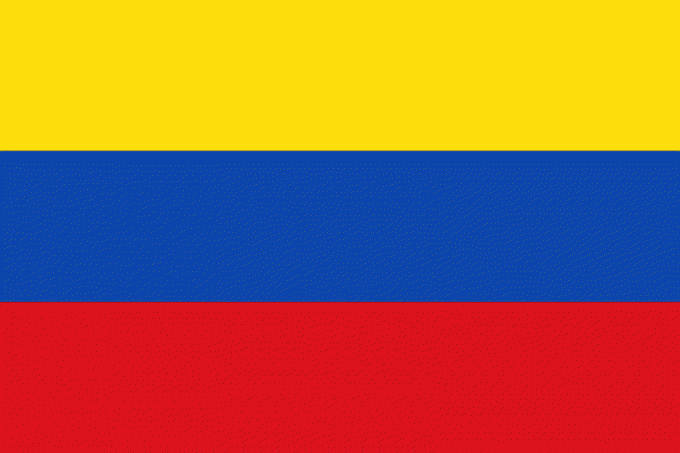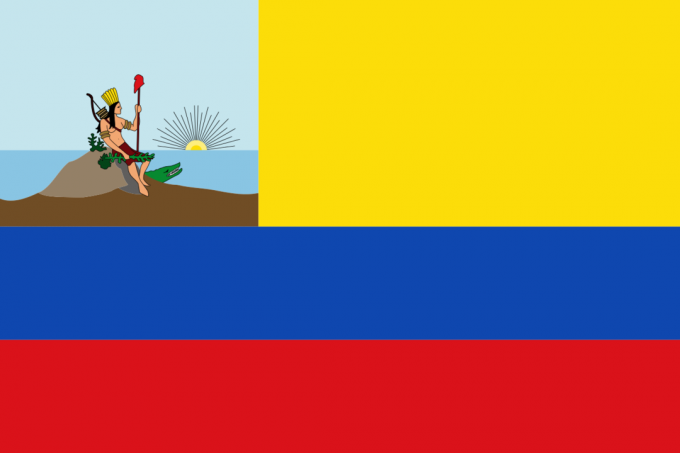The flag of Venezuela is tricolor, composed of vertical stripes of the same size in the colors yellow, blue and red, from top to bottom. In the blue band are 8 stars in a semicircle.
The stars represent the 7 provinces that formed Venezuela in the Act of Independence and the eighth is a tribute to Simon Bolivar (1783-1830), which fought for the independence of the Spanish colony.
The proportion of the Venezuelan pavilion is 2:3. That is, if it is 2 meters wide, it should be 3 meters long.

current flag of Venezuela
flag symbology
The flag of Venezuela is very similar to the flags of Colombia and Ecuador, countries that participated in the same independence process and were part of the Great Colombia, which existed between 1821 and 1831.
Even the meaning of the colors is similar to the pavilion of these countries. In the case of Venezuela, the colors have the following meanings:
- Yellow: represents the country's natural wealth.
- Blue: represents the ocean that separates Venezuela from Spain.
- Red: it represents the blood of those who fought for the country's independence.
See also the meaning of Colombia flag.
History of the Flag of Venezuela
The flag of Venezuela that comes closest to the current one was designed by General Francisco de Miranda (1750-1816) and was hoisted by him for the first time that day March 12, 1806 on your ship Leander, which was on the coast of Haiti.
This flag was first raised on Venezuelan soil on August 3, 1806, in the city of Coro. It was the same as the current flag, but without the stars in the blue band.

Flag hoisted by General Francisco Miranda aboard the ship Leander in 1806.
On July 5, 1811, Venezuela declared its independence and Congress officially adopted the tricolor flag. This one is flown for the first time on the 14th of July.
The yellow band was larger than the blue and red bands, and in the upper left corner of the pavilion a drawing of an Indian woman sitting on a rock, with a crocodile on the ground, was inserted.

Flag of Venezuela between 1811 and 1812.
In 1817, the Federal Government adopted as official the tricolor flag with 7 stars in the yellow band. These stars represented the 7 provinces that together declared independence: Caracas, Cumaná, Barinas, Margarita, Barcelona, Mérida and Trujilo.
Over the years, the Venezuelan pavilion has undergone several changes, but today it has maintained a certain pattern, always characterized by three colors in horizontal bands and 7 5-pointed stars.
the eighth star
The main change would take place in 2006, when the National Assembly, through a Legislative Decree, inserted a star. The eighth star would be a reference to the province of Guayana, which later joined the 7 provinces.
The inclusion of this star is a tribute to Simon Bolivar, who had already requested the recognition of this province in 1817.
Presidential Flag of Venezuela
Used by the Presidency and the Armed Forces, this pavilion is exactly the same as the civil flag, but bears the country's coat of arms in the upper left corner, over a yellow stripe.

Presidential flag of Venezuela.
Venezuela's coat of arms is divided into three barracks with the same colors as the flag. In each of them, there are elements with different symbologies.
- Red barracks: a bundle of wheat that represents the country's wealth and the union of states into a republic.
- Yellow barracks: weapons, two pavilions and laurel leaves, which represent the victory in the War of Independence.
- Blue barracks: a white horse that represents the freedom and independence of the nation.
In addition, the country's flowers and fruits are depicted on the coat of arms. On the sides, we find olive and palm branches, representing peace and virtue, respectively.
Understand what a Republic.
flag day
Since 2006, flag day is celebrated on august 3rd, recalling the date when the flag was first hoisted on Venezuelan soil in 1806. Before that, this celebration took place on March 12, when the pavilion was hoisted on the boat from Leander by General Francisco Miranda.
See also the meaning of Brazil's flag, Canada flag and Russian flag.

